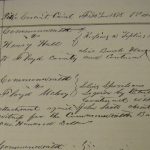Johnse and Roseanna first appeared as Romeo and Juliet in Jean Thomas’s book, “Big Sandy” in 1940.
Eight years later, the magazine writer, Virgil Jones, titled a chapter in his book: “Mountain Romeo and Juliet.” Jones never gave any prior writer credit for stories he purloined, so he does not credit Thomas for this. Both writers said the couple met at an election in 1880. Both Thomas and Jones, and every other writer after them except for this writer, wrote that the couple met at the 1880 election.
The story appears first in the original telling of the story by New York Sun reporter John Spears in 1888. Spears is closer to the truth, as he does not mention an election, referring only to Johnse’s moonshine whiskey business.
Pricy Farley Scott was born in either 1869 or 1870. Pricy grew up two houses above the McCoys on Blackberry Fork of Pond creek. She lived until the late 1960’s. When I was growing up, she lived on the old Randolph McCoy farm, which she and her husband, Crit Scott, had bought in 1902. My sister, Wanda Hatfield, rented a little house from Pricy from 1952-55. The house sat behind Pricy’s house and overlapped the old seat of the McCoy homeplace which was burnt on New Year’s Day of 1888.
Pricy’s father, Ali, and brother, John B. were the first to visit the smoldering remains of the McCoy home on January 2. Pricy saw the corpses of both Calvin and Alifair in the home of the next-door neighbor, John Scott, before they were prepared for burial. Pricy said Alifair was shot just below the left breast, with the bullet lodged against her shoulder blade. Calvin was shot just behind the left ear, the bullet exiting from his right temple, near the eye.
Most writers of feud yarns say that the surviving McCoys spent the remainder of the night outdoors. Pricy said they spent the night at John Scott’s house. To believe the tales, one has to believe that the neighbors of Randolph McCoy heard dozens of rifle shots and saw the flames of the burning home and simply laid back down to sleep, without even checking on their neighbors. This is a libel against people who always came to the aid of neighbors in trouble. Under oath in the 1899 trial of Johnse Hatfield, the prosecutor asked Randolph McCoy where he spent that night. Randolph answered: “At John Scott’s house.” So much for Dean King’s claim that Ran’l snuggled up to couple of hogs in his hog pen.
Pricy was twelve years old, selling gingerbread she had baked at the 1882 election where the three McCoy boys killed Ellison Hatfield. She said that Johnse was there, and that he winked at her every time he passed her table. She said that Johnse loved all the girls and most of them loved him back. She did not doubt that one of the girls who reciprocated was Roseanna McCoy.
Pricy Scott, whose best friends were the daughters of Randolph McCoy, had no memory of any romance that included a stay at the Hatfield home by Roseanna, or of a baby. In his notes at the end of the chapter in Truda McCoy’s book, historian Leonard Roberts wrote of the baby: “Its birth, age and death are not proved.”(p.224) According to Roberts, who talked to everyone who could have had pertinent information, Roseanna’s baby most likely never existed.
Pricy said that the couple undoubtedly knew each other, because Johnse brought wholesale quantities of his father’s moonshine to Roseanna’s brothers for them to resale. Here is a court record of Floyd being charged with “retailing,” which was the charge used when someone was reselling whiskey that they did not actually distill. We know this was Roaeanna’s brother, Floyd, because the named witness is John Scott, next-door neighbor to the McCoys.
(Click to expand)
Dean King, who wrote the biggest yarn of all, runs into some serious timeline trouble with this tale. King knows, because he refers to it, that Johnse married Roseanna’s cousin, Nancy McCoy, in May of 1881. King invents an election that never happened in the spring of 1880 in order to fit all his fictional events into his timeline. His problem is that there were NO elections in the spring in Kentucky until after the 1892 Constitution.
So, from an eyewitness, Pricy Farley Scott, and from the actual court records. I contend that all the yarns about a Romeo and Juliet romance and the tragic death of the baby that resulted are nothing but fiction, just like most of the events in the feud yarns.
PS: The entry above Floyd McCoy in that court record is historically important. Henry Hall was the last man hanged in Pike County, Kentucky. Hall was hanged in 1892, two years after the hanging of Ellison Mounts. Hall killed his brother in an argument over a poker game and, for some unfathomable reason, the jury sentenced him to death. Here Hall is accused of “Keeping a Tippling House,” which was what they charged one with when he was running an unlicensed saloon.
So, of the last two men hanged in my home county, one was innocent (Mounts) and the other was guilty of manslaughter.
But that was the way it was.
